|

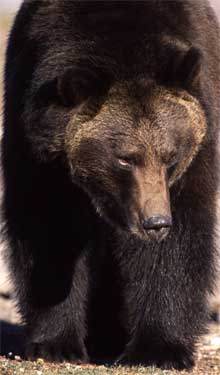 Not sure which coat to wear: Brown Bears have furry coats in shades of blonde, brown, black, or a combination of those colors; the long outer guard hairs are often tipped with white or silver, giving a "grizzled" appearance. Brown bears have a large hump of muscle over their shoulders which give strength to the forelimbs for digging. Their forearms end in massive paws tipped with extremely powerful claws that can be up to 5.9 inches in length. Unlike the claws of other large predatory animals, such as lions or tigers, the claws are not retractable. This gives the claws a dull edge when compared to other predators. Despite the relatively dull edges to their claws, the sheer force of a blow from a large specimen is devastating. However, these claws are mainly used for digging, not for hunting. It uses its sharp canine teeth for neck-biting its prey when hunting. Bears use the same technique as tigers when hunting: they ambush their prey. Their heads are large and round with a concave facial profile. In spite of their size, some have been clocked at speeds in excess of 35 mph. Along with their strength and deceptive speed, Brown Bears are legendary for their physical stamina. They are capable of running at full speed for miles at a time without stopping. The largest subspecies of the Brown Bear are the Kodiak Bear and Alaskan Coastal Bear. Some exceptionally large male Kodiak stand over 10 feet in height while on their hind legs, and weigh over 1,500 lb. Not sure which coat to wear: Brown Bears have furry coats in shades of blonde, brown, black, or a combination of those colors; the long outer guard hairs are often tipped with white or silver, giving a "grizzled" appearance. Brown bears have a large hump of muscle over their shoulders which give strength to the forelimbs for digging. Their forearms end in massive paws tipped with extremely powerful claws that can be up to 5.9 inches in length. Unlike the claws of other large predatory animals, such as lions or tigers, the claws are not retractable. This gives the claws a dull edge when compared to other predators. Despite the relatively dull edges to their claws, the sheer force of a blow from a large specimen is devastating. However, these claws are mainly used for digging, not for hunting. It uses its sharp canine teeth for neck-biting its prey when hunting. Bears use the same technique as tigers when hunting: they ambush their prey. Their heads are large and round with a concave facial profile. In spite of their size, some have been clocked at speeds in excess of 35 mph. Along with their strength and deceptive speed, Brown Bears are legendary for their physical stamina. They are capable of running at full speed for miles at a time without stopping. The largest subspecies of the Brown Bear are the Kodiak Bear and Alaskan Coastal Bear. Some exceptionally large male Kodiak stand over 10 feet in height while on their hind legs, and weigh over 1,500 lb.

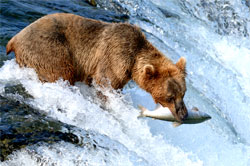 A Winter's Tale: The Brown bear is primarily nocturnal and, in the summer, puts on up to 400 lbs of fat, on which it relies to make it through winter, when it becomes very lethargic. Although they are not true hibernators and can be woken easily, they like to den in a protected spot such as a cave, crevice, or hollow log during the winter months. A Winter's Tale: The Brown bear is primarily nocturnal and, in the summer, puts on up to 400 lbs of fat, on which it relies to make it through winter, when it becomes very lethargic. Although they are not true hibernators and can be woken easily, they like to den in a protected spot such as a cave, crevice, or hollow log during the winter months.
Strict Diet: They are omnivores and feed on a variety of plant parts, including berries, roots, and sprouts; fungi; and fish, insects, and small mammals. Contrary to popular mythology, Brown Bears are not particularly carnivorous; they derive up to three-quarters of their dietary food energy from vegetable matter. Their jaws structure has been adapted to this diet habit, it is longer and lacks strong, sharp canine teeths of true predators. Interestingly, bears eat an enormous number of moths during the summer (sometimes as many as 20,000 to 40,000 in a day) and may derive up to a third of their food energy from these insects. They also occasionally prey on deer, Red Deer, moose. When a Brown bear attacks these animals, it carefully chooses young calves or aged, sick adults as they are slow and weak, thus will not be able to outrun the bear or put up resistance, which sometimes proves fatal to the hunter. Brown bears have also been found stealing the kills of tigers, wolves, and pumas. In areas where Brown bears and Siberian tigers coexist, Brown bears are opportunists who often follow tigers's tracks to dispute its kill.
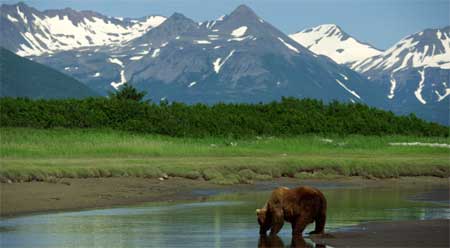

Mommy Dearest: Normally a solitary animal, the Brown bear congregates alongside streams and rivers during the salmon spawn in the fall. Every other year females produce one to four young, which weigh only about 2 to 5 lb at birth. Raised entirely by their mother, the cubs are taught to climb trees at the sign of danger.

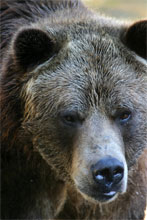 Bear Attack: It is extremely rare that Brown bears kill or seriously injure humans but fatal encounters do happen. There are an average of two fatal attacks a year in North America. In Scandinavia there are only three known cases during the last 100 years where humans have been killed by bears. This has usually happened because the bear is injured or a human encounters a mother bear with cubs. Some types of bears such as Polar bears, are more likely to attack humans when searching for food while American Black bears are much less likely to attack. Bear Attack: It is extremely rare that Brown bears kill or seriously injure humans but fatal encounters do happen. There are an average of two fatal attacks a year in North America. In Scandinavia there are only three known cases during the last 100 years where humans have been killed by bears. This has usually happened because the bear is injured or a human encounters a mother bear with cubs. Some types of bears such as Polar bears, are more likely to attack humans when searching for food while American Black bears are much less likely to attack.
The Scandinavian Bear Research project lists the following situations as potentially dangerous:
1. Meeting an injured bear
2. A human suddenly appearing between a mother and her cubs
3. Meeting a bear in its cave
4. Meeting a bear who has been provoked by a dog
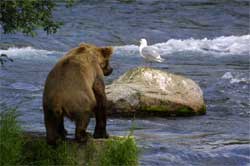 Walk softly and carry a big stick: A careful person should always try to avoid these situations. Anybody who walks in a forest where there are bears could carry around an air horn (so called 'bear bells' tend to provoke a bear's curiosity) since a Brown bear's natural instinct is to run away from humans; in groups trail songs are also effective. Walk softly and carry a big stick: A careful person should always try to avoid these situations. Anybody who walks in a forest where there are bears could carry around an air horn (so called 'bear bells' tend to provoke a bear's curiosity) since a Brown bear's natural instinct is to run away from humans; in groups trail songs are also effective.
If camping, do not bring food into the tent and be sure to clean up all garbage; a bear thinks with its stomach. If one still meets a bear it is
important to remain calm and to slowly walk in the opposite direction. A running human may trigger the bear's chasing instinct and a bear can outrun a human adult in terms of both speed and stamina. It is important not to make threatening moves, not to make eye contact nor to shout.
Play Dead: If a Brown bear attacks and it is not possible to get away, the person should lie down in a fetal position and put his/her hands around the head to protect from bites. This may reduce damage to vital organs. Not panicing and pretending to be dead might save you.
All text is available under the terms
of the GNU Free Documentation License
|